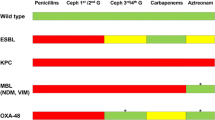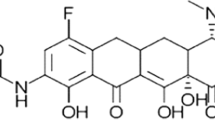Abstract
A clinical trial was conducted in 50 patients with blood cultures positive forSalmonella typhi or Salmonella paratyphi to compare treatment with ciprofloxacin for seven days, 500 mg b.i.d. (Group 1, 25 patients), with treatment for ten days, 750 mg b.i.d. (Group 2, 25 patients). Clinical cure was defined as defervescence of fever by day 5 of treatment, with an absence of complications and no clinical relapse. The clinical cure rate was 84% for group 1 and 96% for group 2; the difference in these rates was not statistically significant. The blood cultures of all patients were sterile by day 2 of treatment and remained so until the sixth month of follow-up. It was concluded that ciprofloxacin treatment for ten days in enteric fever is not necessary. Further studies are needed to evaluate the efficacy of shortening the duration of antibiotic therapy.
Similar content being viewed by others
References
Asperilla MO, Smego RA, Scott LK: Quinolone antibiotics in the treatment of salmonella infections. Reviews of Infectious Diseases 1990, 12: 873–889.
Dupont HL: Quinolones inSalmonella typhi infection. Drugs 1993, 45, Supplement 3: 119–124.
National Committee for Clinical Laboratory Standards: Performance standards for antimicrobial disk susceptibility tests. Approved standard M2-A4. NCCLS, Villanova, PA, 1990.
Stanley PJ, Flegg PJ, Mandal BK, Geddes AM: Open study of ciprofloxacin in enteric fever. Journal of Antimicrobial Chemotherapy 1989, 23: 789–791.
Limson BM, Littaua RT: Comparative study of ciprofloxacin versus co-trimoxazole in the treatment ofSalmonella enteric fever. Infection 1989, 17: 105–106.
Eykyn SJ, Williams H: Treatment of multiresistantSalmonella typhi with oral ciprofloxacin. Lancet 1987, 2: 1407–1408.
Carbon C, Weber P, Levy M, Boussougant Y, Cerf M: Short term ciprofloxacin therapy for typhoid fever. Journal of Infectious Diseases 1987, 155: 833.
Ramirez CA, Bran JL, Mejia CR, Garcia JF: Open, prospective study of the clinical efficacy of ciprofloxacin. Antimicrobial Agents and Chemotherapy 1985, 28: 128–132.
Çetingül N, Akilli M, Sönmez F: Cases ofSalmonella infection in the Aegean region of Turkey. Turkish Journal of Infection 1990, 4: 21–28.
Acharya G, Butler T, Ho M, Sharma PR, Tiwari M, Adhikari RK, Khagda JB, Pokhrel B, Pathak UN: Treatment of typhoid fever: randomized trial of a three-day course of ceftriaxone versus a fourteen day course of chloramphenicol. American Journal of Tropical Medicine and Hygiene 1995, 52: 162–165.
Smith MD, Duong NM, Hoa NT, Wain J, Ha HD, Diep TS, Day NP, Hien TT, White NJ: Comparison of ofloxacin and ceftriaxone for short-course treatment of enteric fever. Antimicrobial Agents and Chemotherapy 1994, 38: 1716–1720.
Author information
Authors and Affiliations
Rights and permissions
About this article
Cite this article
Agalar, C., Usubütün, S., Tütüncü, E. et al. Comparison of two regimens for ciprofloxacin treatment of enteric infections. Eur. J. Clin. Microbiol. Infect. Dis. 16, 803–806 (1997). https://doi.org/10.1007/BF01700409
Issue Date:
DOI: https://doi.org/10.1007/BF01700409




